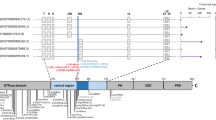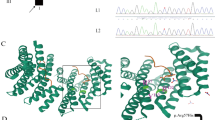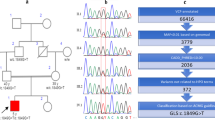Abstract
The cyclin-dependent kinase like 5 (CDKL5) gene variation is X-linked dominant and is associated with type 2 developmental and epileptic encephalopathy (DEE). Although numerous cases of CDKL5 have been reported, there is limited discussion regarding functional verification. We described two children with DEE caused by de novo variations of CDKL5 gene, analyzed their clinical manifestations, and performed genetic testing on their gene variation sites. The two cases presented with tonic seizures followed by epileptic spasms, indicative of refractory epilepsy. Physical examination revealed abnormal facial features, including wide eye distance, low nose base, and high nose bridge. Both cases exhibited developmental disabilities. Cranial magnetic resonance imaging (MRI) showed widening of the bilateral frontotemporal extracerebral space. Genetic testing identified variations at the gene sites c.463 + 4A > G (splicing) and c.1854_1861delCAAAGTGA (p.D618Efs*18). Minigene experiments further confirmed that the intronic variation c.463 + 4A > G (splicing) disrupted splicing, leading to protein truncation. CDKL5 gene variation can lead to DEE, and intron variation site c.463 + 4A > G (splicing) can cause protein truncation, which is a pathogenic variation.











Similar content being viewed by others
Data availability
This published article includes all of the data generated or analyzed during this study.
References
Bahi-Buisson N, Bienvenu T (2012) CDKL5-related disorders: from clinical description to molecular genetics. Mol Syndromol 2(3–5):137–152. https://doi.org/10.1159/000331333
Báez-Mendoza R, Schultz W (2013) The role of the striatum in social behavior. Front Neurosci 7:233. https://doi.org/10.3389/fnins.2013.00233
Zhu YC, Xiong ZQ (2019) Molecular and synaptic bases of CDKL5 disorder. Dev Neurobiol 79(1):8–19. https://doi.org/10.1002/dneu.22639
Katayama S, Sueyoshi N, Inazu T, Kameshita I (2020) Cyclin-dependent kinase-like 5 (CDKL5): possible cellular signalling targets and involvement in CDKL5 deficiency disorder. Neural Plast 2020:6970190. https://doi.org/10.1155/2020/6970190
Piacentini C, Menghini P, Setti M (1988) An external aprismatic layer on temporary and permanent teeth. Bulletin du Groupement Int pour la Recherche Scientifique en Stomatologie & Odontologie 31(3–4):177–187
Wang HT, Zhu ZA, Li YY, Lou SS, Yang G, Feng X et al (2021) CDKL5 deficiency in forebrain glutamatergic neurons results in recurrent spontaneous seizures. Epilepsia 62(2):517–528. https://doi.org/10.1111/epi.16805
Demarest ST, Olson HE, Moss A, Pestana-Knight E, Zhang X, Parikh S et al (2019) CDKL5 deficiency disorder: relationship between genotype, epilepsy, cortical visual impairment, and development. Epilepsia 60(8):1733–1742. https://doi.org/10.1111/epi.16285
Richards S, Aziz N, Bale S, Bick D, Das S, Gastier-Foster J et al (2015) Standards and guidelines for the interpretation of sequence variants: a joint consensus recommendation of the American College of Medical Genetics and Genomics and the Association for Molecular Pathology. Genet Med 17(5):405–424. https://doi.org/10.1038/gim.2015.30
Rosas-Vargas H, Bahi-Buisson N, Philippe C, Nectoux J, Girard B, N’Guyen Morel MA et al (2008) Impairment of CDKL5 nuclear localisation as a cause for severe infantile encephalopathy. J Med Genet 45(3):172–178. https://doi.org/10.1136/jmg.2007.053504
Bahi-Buisson N, Kaminska A, Boddaert N, Rio M, Afenjar A, Gérard M et al (2008) The three stages of epilepsy in patients with CDKL5 mutations. Epilepsia 49(6):1027–1037. https://doi.org/10.1111/j.1528-1167.2007.01520.x
Mirzaa GM, Paciorkowski AR, Marsh ED, Berry-Kravis EM, Medne L, Alkhateeb A et al (2013) CDKL5 and ARX mutations in males with early-onset epilepsy. Pediatr Neurol 48(5):367–377. https://doi.org/10.1016/j.pediatrneurol.2012.12.030
Lilles S, Talvik I, Noormets K, Vaher U, Õunap K, Reimand T et al (2016) CDKL5 gene-related epileptic encephalopathy in Estonia: four cases, one novel mutation causing severe phenotype in a boy, and overview of the literature. Neuropediatrics 47(6):361–367. https://doi.org/10.1055/s-0036-1586730
Siri B, Varesio C, Freri E, Darra F, Gana S, Mei D et al (2021) CDKL5 deficiency disorder in males: five new variants and review of the literature. Eur J Paediatric Neurol 33:9–20. https://doi.org/10.1016/j.ejpn.2021.04.007
Zhao Y, Zhang X, Bao X, Zhang Q, Zhang J, Cao G et al (2014) Clinical features and gene mutational spectrum of CDKL5-related diseases in a cohort of Chinese patients. BMC Med Genet 15:24. https://doi.org/10.1186/1471-2350-15-24
Author information
Authors and Affiliations
Contributions
BG L carried out the studies, participated in collecting data, and drafted the manuscript. ZZ Q participated in the acquisition, analysis, and interpretation of data and drafted the manuscript. WP W participated in project guidance. All authors read and approved the final manuscript.
Corresponding authors
Ethics declarations
Ethics approval and consent to participate
All procedures were performed in accordance with the ethical standards laid down in the 1964 Declaration of Helsinki and its later amendments. This study was approved by Ethics Committee of Hebei Children’s Hospital and Institutional Review Board of Hebei Children’s Hospital (approval number 2021[152]). Participants have consented to the submission of the case report.
Consent for publication
The participants have consented to the submission of the case report.
Competing interests
The authors declare no competing interests.
Additional information
Publisher's note
Springer Nature remains neutral with regard to jurisdictional claims in published maps and institutional affiliations.
Rights and permissions
Springer Nature or its licensor (e.g. a society or other partner) holds exclusive rights to this article under a publishing agreement with the author(s) or other rightsholder(s); author self-archiving of the accepted manuscript version of this article is solely governed by the terms of such publishing agreement and applicable law.
About this article
Cite this article
You, Y., Men, X., Wu, W. et al. Clinical and functional study of two de novo variations of CDKL5 gene. Neurogenetics 24, 263–271 (2023). https://doi.org/10.1007/s10048-023-00731-x
Received:
Accepted:
Published:
Issue Date:
DOI: https://doi.org/10.1007/s10048-023-00731-x




